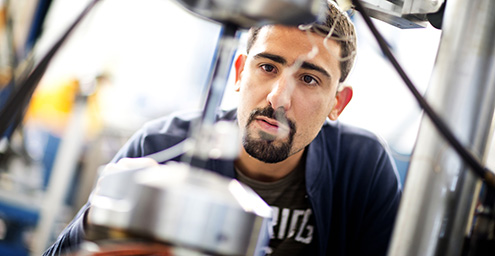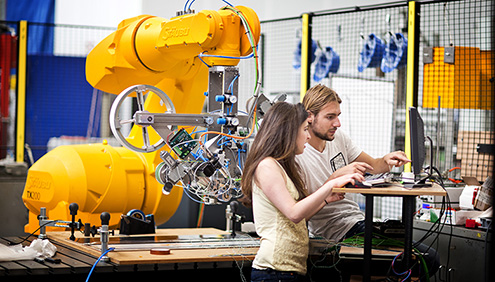
The faculty of Aerospace Engineering introduces four major multidisciplinary research themes. Goal: bringing research areas and people together to speed up innovation for (urgent issues in) society .
“Today’s customers – whether they’re buying a telephone, automobile or aircraft - do not want to buy the exact same product as everybody else. They want customised products, still of the same high quality, still affordable and deliverable right now”, says Rinze Benedictus, theme leader Smart Manufacturing. “ Even large passenger aircraft, such as the Airbus A320 Neo, are customised to the specific needs of the buying airline. This calls for cost-effective, fast and flexible new production processes: Smart Manufacturing, also called Industry 4.0 or Smart Industry. The faculty focuses on smart manufacturing of safety critical loadbearing structures, such as aircraft, automobiles, wind turbines or bridges, but expects the technology can be used for other production lines as well.
Smart manufacturing: how does it work?
“Toyota once set the standard for the quality management of mass producing identical products”, says Professor Aerospace Structures and Materials and Smart Manufacturing theme leader, Rinze Benedictus. “ Now we need a new standard for mass producing customised products.” In smart manufacturing processes technology such as sensors, feedback loops, Big Data and 3D printing is used. It works in a number of different ways, such as:
- It repairs errors during production, reducing wastage of materials. A robot with integrated sensors can for example measure the quality of the product as it is made and repair it simultaneously. This prevents finished but flawed products to be thrown away.
- It gives us data that helps to design, scale up and implement innovative, robust and flexible new production lines with which we can develop entirely new innovations. Smart manufacturing will make it easier and cheaper to determine whether an innovative idea is a viable product, speeding up the time to market.
- 3D printers make production more flexible and less confined to one particular factory. Need a new component in the International Space Station? It can be produced right there in space.
Benedictus: “In the end, smart manufacturing will benefit customers, it contributes to more sustainable production of products, it will create hundreds of thousands of new jobs at intermediate level in Europe, give us back our competitive edge and it will be a blessing for bringing innovations to the market. “
Why now?
Researcher Calvin Rans works alongside Benedictus on the smart manufacturing research theme: “Almost every modern company today has already implemented parts of smart manufacturing, whether it’s Airbus or a semiconductor factory in China. It’s a buzzword now because the technology is ready to start integrating disciplines, such as material science, product design, sensor technology, manufacturing processes and in-depth knowledge of customer trends and needs. In addition, production processes have become so complicated that they simply can’t be done in traditional, analogue ways anymore. Image the costs if Airbus needs to build a whole new production line for every single version of the A320 Neo.”
Challenges
There are several hurdles to overcome. Rans: “One challenge is to know what to do with all the data we get from measurements during production processes. What is sensible data and what isn’t? Can you use it in such a way that e.g. a feedback loop becomes self-learning? Integrating many different disciplines is another challenge. The smarter the product and the production process the more an engineer needs to integrate (and thus understand) different design and manufacturing disciplines. This requires different type of engineer. As we currently educate engineers on the basis of manufacturing methods of the past or single disciplines, we will have a thorough look at our education programme as well.”

Aerospace engineering and smart manufacturing
The faculty of Aerospace Engineering is bringing together researchers, lecturers, students and external partners to focus on the smart manufacturing of composite load bearing structures, such as aircraft and automobiles. Special attention will be given to the smart manufacturing of smart structures, such as multifunctional aircraft coatings that protect the aircraft and generate or store electricity at the same time. The technology developed for producing aircraft in particular can also be used in production lines for other products. Rans: “The production of aircraft sets the parameters that apply to production lines for other structural designs as well. An aircraft is a high-tech load bearing structure with incredible weight constraints and safety measures.”
Benedictus: “For smart manufacturing you really need to understand the end product and tailor it to the customer’s needs. We know how to produce aircraft. Now we will integrate separate disciplines, such as structures and materials, propulsion systems and airline requirements to accelerate smart manufacturing. This theme will leverage the work we’re already doing in the area of manufacturing of aircraft within departments in order to speed up applying science for the benefit of society. “
Contact

Prof. dr. Rinze Benedictus
E: R.Benedictus@tudelft.nl

Dr. Calvin Rans
E: C.D.Rans@tudelft.nl

Dr.ir. Sotiris Koussios
E: S.Koussios@tudelft.nl
-
Assistant Professor Structural Integrity and Composites Sotiris Koussios researches automated fibre placement processes: Filament Winding, Tape Laying and Fibre Placement. Koussios focuses on an integral approach of design, materials selection, and production methodologies: “Optimising the production process during the design stage leads to better quality and less costs.
At the same time, smart manufacturing procedures, such as quality monitoring during production, closed loop controls for adapted machine motion and fibre handling, and the implementation of Digital Image Correlation for auto-referencing, parts pick& place and tool exchange, will lead to more autonomous production cells that require less preparation time, prototyping and troubleshooting.” Koussios also works on combination techniques such as overmoulding, over-taping and the fusion of braiding/filament winding and pultrusion. He collaborates closely with partner RWTH in Aachen, a strong player in the field of smart manufacturing research. Koussios: “High performance composite structures are entering high volume applications in the areas of automotive, marine and civil engineering . Research is needed to keep a good balance between performance and costs. Also, improvement of the structural and physical properties of composite (sub-) components by a high degree of automation, in-line quality monitoring and smarter logistics will lead to even lighter, safer and more economical aerospace applications as well. These improvements contribute to the reduction of energy consumption for both static and moving structures.”

Irene Fernandez Villegas
Smart joining

Roger Groves
Smart Sensing

Otto Bergsma
Next level accuracy and consistency